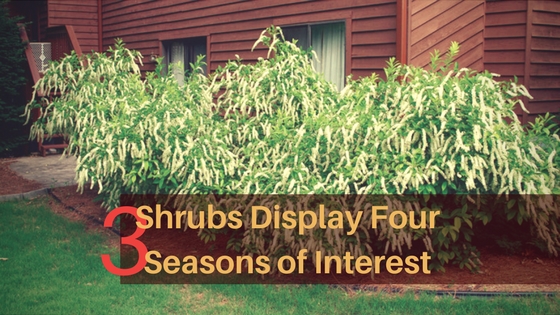3 Shrubs Display Four Seasons of Interest
Some bushes and shrubs produce a glorious display of spring flowers or fall foliage but then are rather inconspicuous during the rest of the year. However, there are several landscaping bushes that will add four seasons of color or interest to the home garden. When considering new landscaping plants, think about planting bushes like viburnums, Virginia sweetspire and bearberry. These shrubs are very versatile and add texture, color, foliage or flowers to the landscape in spring, summer, fall and winter.
To begin planning, consider the existing landscaping and select the proper shrub for the size needed, location, weather conditions and soil. For example, Vibirnums come in many sizes but Virginia sweetspire is mid-sized and bearberry is tall. Most shrubs prefer full sun and can grow in most types of well-drained soil, though Virginia sweetspire can tolerate damp locations.
3 Shrubs for everlasting beauty
Virburnum

Virburnums come in a wide range of sizes, from dwarf to ten feet tall. They are good for ornamental hedges. Most have pink or white flowers in spring, berries and textured leaves. In the fall the leaves turn reddish purple. In winter the graceful branches add interest and look especially nice with snow on them. The leaves linger on in winter, adding both color and texture. Viburnum grows best in full sun and well-drained soil but it can tolerate most conditions. It has an adaptable root system making them easily transplantable. Most diseases and pests do not bother this shrub.
Check out: Pruning and Cutting Guide to learn how to prune your shrubs properly
Virginia Sweetspire

Virginia sweetspire (Itea virginica ) is a deciduous shrub that stays small. It is good for use in pots and only grows to about 4 feet tall. This shrub bears pleasant smelling white flowers in July and has colorful foliage in the fall. The flowers are white and clustered on long elegant stems and the blossoms closer to the base of this stem open first. Birds and butterflies love this plant. Virginia sweetspire has medium or dark green leaves that turn orange, yellow and red in the fall. Dark red stems add winter color. It is drought tolerant and prefers slightly acidic soil. It is native to damp areas in the US, but is also drought tolerant. Be aware that Virginia sweetspire spreads by runners and can become invasive.
Bearberry

Bearberry (Arctostaphylos) has many names. Some call it kinnikinnick, which means “mixture” in Algonquin because the Native Americans mixed it with tobacco and smoked it. It has red berries that bears love, hence the common name. Bearberry is also called hog cranberry, sandberry, foxberry, crowberry. This evergreen shrub is generally 6-12’ tall and 3-15’ wide. The stems trail and make a good groundcover. It is drought tolerant and attracts birds and hummingbirds. Bearberry prefers well-drained, sandy, acidic soils but can tolerate most other kinds. It grows slowly and does not like high temperatures. Bearberry flowers with small, bell shaped pink or white blossoms in spring. The small, dark green leathery leaves turn bronze in autumn. The thin red bark peels and adds color and texture in winter. The berries also stay on the bushes through the winter. Bearberry can be difficult to transplant or become established.
Care When Planting New Shrubs
Once a new shrub like virburnum, Virginia sweetspire or bearberry has been selected, it can be purchased from a local garden center or online garden retailer as burlap wrapped root balls or in plastic pots. These shrubs are best added to the landscape in either the spring or fall, but can be planted at any time the ground is not frozen or dry from summer heat. Dig the hole as deep as the soil level around the new shrub and twice as wide as the root ball. Loosen the soil in the hole so the plant can more easily take root. Gently remove the pot or wrapping and add the plant to the hole. Firmly pack the soil around the plant and water well. With careful watering, the new shrub should add color, flowers and foliage variety to the home landscape for years to come.


